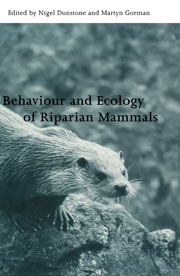Book contents
- Frontmatter
- Contents
- List of contributors
- Preface
- 1 Adaptations to the semi-aquatic habit and habitat
- 2 Physiological challenges in semi-aquatic mammals: swimming against the energetic tide
- 3 Diving capacity and foraging behaviour of the water shrew (Neomys fodiens)
- 4 Habitat use by water shrews, the smallest of amphibious mammals
- 5 The importance of the riparian environment as a habitat for British bats
- 6 A preliminary study of the behaviour of the European mink Mustela lutreola in Spain, by means of radiotracking
- 7 The demography of European otters Lutra lutra
- 8 Habitat use and conservation of otters (Lutra lutra) in Britain: a review
- 9 The relationship between riverbank habitat and prey availability and the distribution of otter (Lutra lutra) signs: an analysis using a geographical information system
- 10 Influence of altitude on the distribution, abundance and ecology of the otter (Lutra lutra)
- 11 Diets of semi-aquatic carnivores in northern Belarus, with implications for population changes
- 12 Otter (Lutra lutra) prey selection in relation to fish abundance and community structure in two different freshwater habitats
- 13 Diet, foraging behaviour and coexistence of African otters and the water mongoose
- 14 Feeding ecology of the smooth-coated otter Lutra perspicillata in the National Chambal Sanctuary, India
- 15 Population trends of hippopotami in the rivers of the Kruger National Park, South Africa
- 16 Reproductive strategies of female capybaras: dry-season gestation
- 17 The continuing decline of the European mink Mustela lutreola: evidence for the intraguild aggression hypothesis
- 18 Otters and pollution in Spain
- 19 The rapid impact of resident American mink on water voles: case studies in lowland England
- 20 Status, habitat use and conservation of giant otter in Peru
- Index
6 - A preliminary study of the behaviour of the European mink Mustela lutreola in Spain, by means of radiotracking
Published online by Cambridge University Press: 03 May 2010
- Frontmatter
- Contents
- List of contributors
- Preface
- 1 Adaptations to the semi-aquatic habit and habitat
- 2 Physiological challenges in semi-aquatic mammals: swimming against the energetic tide
- 3 Diving capacity and foraging behaviour of the water shrew (Neomys fodiens)
- 4 Habitat use by water shrews, the smallest of amphibious mammals
- 5 The importance of the riparian environment as a habitat for British bats
- 6 A preliminary study of the behaviour of the European mink Mustela lutreola in Spain, by means of radiotracking
- 7 The demography of European otters Lutra lutra
- 8 Habitat use and conservation of otters (Lutra lutra) in Britain: a review
- 9 The relationship between riverbank habitat and prey availability and the distribution of otter (Lutra lutra) signs: an analysis using a geographical information system
- 10 Influence of altitude on the distribution, abundance and ecology of the otter (Lutra lutra)
- 11 Diets of semi-aquatic carnivores in northern Belarus, with implications for population changes
- 12 Otter (Lutra lutra) prey selection in relation to fish abundance and community structure in two different freshwater habitats
- 13 Diet, foraging behaviour and coexistence of African otters and the water mongoose
- 14 Feeding ecology of the smooth-coated otter Lutra perspicillata in the National Chambal Sanctuary, India
- 15 Population trends of hippopotami in the rivers of the Kruger National Park, South Africa
- 16 Reproductive strategies of female capybaras: dry-season gestation
- 17 The continuing decline of the European mink Mustela lutreola: evidence for the intraguild aggression hypothesis
- 18 Otters and pollution in Spain
- 19 The rapid impact of resident American mink on water voles: case studies in lowland England
- 20 Status, habitat use and conservation of giant otter in Peru
- Index
Summary
Introduction
The European mink, Mustela lutreola, is one of the least–known mustelids in Europe (Youngman, 1982; Camby, 1990; Saint–Girons 1991). The species is, moreover, declining in number and many populations have disappeared (Romanowski, 1990; Saint–Girons 1991; Rozhnov, 1993). Formerly, mink were widely distributed through Europe, but today are found only in some eastern European countries (Sidorovich, 1991; Maran, 1992; Tumanov, 1992), in a small area of southern France (Braun, 1990; Camby, 1990; C. Maizeret, unpublished results) and in northern Spain (Ruiz–Olmo & Palazón, 1991; Palazón & Ruiz–Olmo, 1992; Gosàlbez et al., 1995). Thus, Mustela lutreola is one of the five most endangered small carnivore taxa in the Palaearctic (Schreiber et al., 1989).
The European mink was recorded in Spain during the middle of the twentieth century (Rodriguez de Ondarra 1955). Subsequently, the species expanded to the south and east, following the main river basins, principally the Ebro river (Palazón & Ruiz–Olmo, 1995). Today Spain is the only area in the world where Mustela lutreola is not in decline. The arrival of mink in certain areas of Spain has presumably meant adaptation to a new environment: the Mediterranean ecosystem. Here, most of the rivers have no polecats, Mustela putoriusy American mink, Mustela vison, or otters, Lutra lutra (Delibes, 1990; Ruiz–Olmo & Delibes, 1998).
- Type
- Chapter
- Information
- Behaviour and Ecology of Riparian Mammals , pp. 93 - 106Publisher: Cambridge University PressPrint publication year: 1998
- 6
- Cited by



